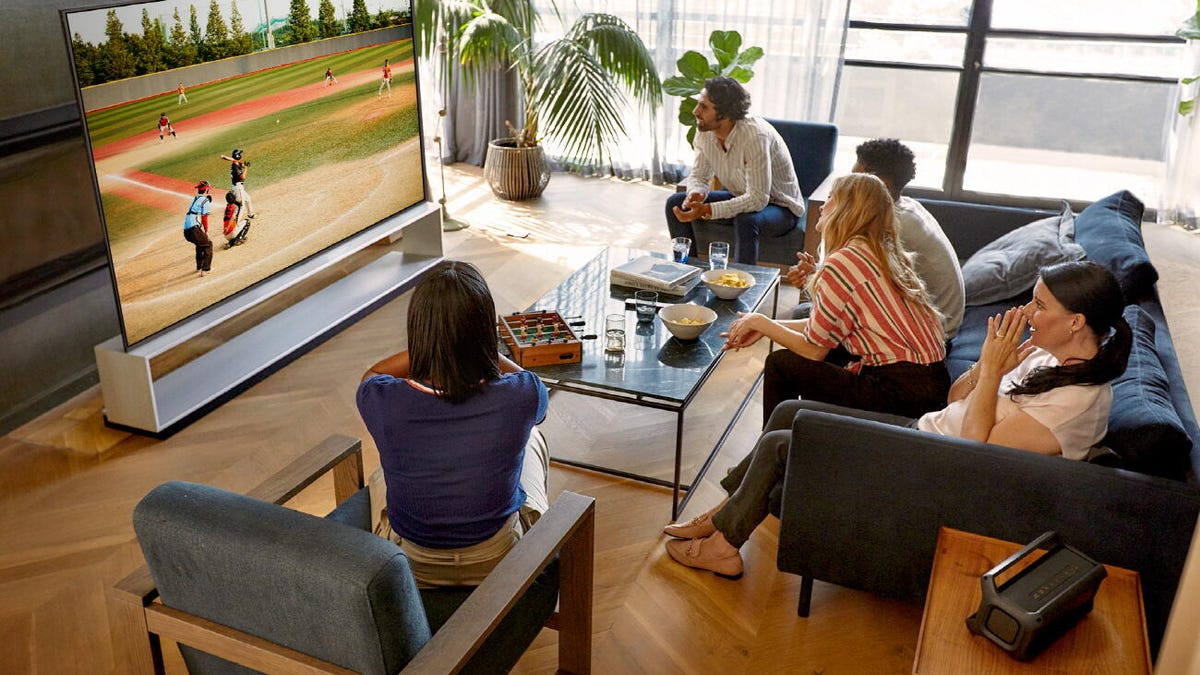LG OLED TVs get better processing, ATSC 3.0 tuners, 48-inch size
Our favorite high-end TVs make mostly incremental improvements yet remain on the cutting edge.

Just your typical sports fans enjoying a $30,000 88-inch 8K OLED TV.
OLED TV isn't broke, and in 2020 LG didn't fix it. The company's CES 2020 lineup includes a few neat extras but nothing that would make a current owner regret his or her purchase. In fact, the biggest addition is a smaller size option: for the first time you'll be able to buy a 48-inch OLED TV. LG has yet to announce pricing, but it did tell me that the 48-inch model would cost less than the 55-inch version, making the new smallest OLED also the least expensive.
TVs powered by organic light emitting diode (OLED) technology are the best high-end models available and consistently outperform LCD-based TVs, including Samsung's QLED models, in our reviews. In addition to LG, Sony also makes OLED TVs in the US, and later this year Vizio, Konka and Skyworth (not a misprint) will throw their hats into the ring. Even Samsung is getting into the OLED game in the next few years.
See also
- CNET's 20 favorite products of CES 2020
- All the cool new gadgets at CES 2020
- Full coverage of CES 2020
LG is the king of OLED TV, however, and its 2020 lineup includes 6 series starting with a pair of ultra-high-end choices: the rollable RX series (spoiler: it costs $60,000) and the 8K resolution ZX models at 77- and 88-inches each (no pricing yet but the current 88-inch 8K OLED costs $30,000). Don't worry, there's also plenty of options for mere mortals, too. Here's the details, starting with what's new.
Previously the smallest LG OLED TV was 55-inches but in 2020 LG will sell a 48-inch version for the first time.
New features for 2020
A9 Gen 3 processor: Most 2020 LG OLED TVs (with the exception of the BX) will get LG's latest processor. Compared to the A9 Gen 2 found on 2019 models like the C9, it has improved "AI picture enhancement" technology and can automatically optimize picture and sound quality based on genre. I've found it tough to spot processing differences in the past and I'd be surprised if things were any different this year.
ATSC 3.0 (aka NextGen TV) over-the-air tuners: LG's higher-end OLED TVs (the GX series and up) will be among the first to include built-in tuners that work with the next-generation of free antenna TV broadcasts, which are already coming online. They promise 4K HDR compatibility, better reception indoors and more.
Far-field voice control: Higher-end models (again, the GX and up) will have microphones that can be set to always-on, always listening so you won't have to use the voice remote to access LG's own ThinQ voice service ("Hi, LG"). Like last year, LG TVs have both Google Assistant and Amazon Alexa built in but to access them you'll need to speak into the remote.
AMD FreeSync and Nvidia G-Sync gaming: LG introduced G-Sync last year, and in 2020 it's adding FreeSync, another extra that should improve gaming quality via variable refresh rate with compatible PCs and consoles. Samsung TVs have offered FreeSync for the last couple of years.
Filmmaker mode: In addition to Dolby Vision and Dolby Atmos, all 2020 OLED models get a new picture mode designed to better reflect the director's intent by disabling the soap opera effect and tweaking other picture and processor settings. It will replace the Technicolor mode found on older LG sets.
Who? Where? What?: A new smart TV option will automatically analyze TV shows and movies to "provide real-time information about people, places and shopping within the content you're watching." It uses the same kind of automatic content recognition (ACR) as ad trackers and, in the demos I saw, behaved like a combination of Shazam and Amazon's X-Ray feature. And yes, that is its real name.
LG's Gallery OLED TV is just 23mm thick and has a special wall-hugging mount.
Lineup breakdown
RX series (65-inch): LG introduced its roll-up TV last year but it will take until early 2020 to actually ship. And at 60 grand apiece, don't expect it to ship many. In case you missed it, the RX is an incredible piece of engineering: a 65-inch TV rolls up like a poster to disappear when not in use. On the downside it's missing the ATSC 3.0 tuner and G-Sync/FreeSync compatibility found on most of the other models.
ZX series (77- and 88-inch): This year's other OLED for profligate wastrels -- the one with 8K resolution -- comes in two massive sizes. You won't be able to afford either one.
WX series (65- and 77-inch): The superthin "wallpaper" OLED TV is not 8K, but given that the 2019 models start at six grand, it's not affordable either.
GX series (55-, 65- and 77-inch): The kinda-more-mainstream models start here with an all-new design twist. The chassis of the "Gallery" GX is ultrathin, just 20mm in depth and comes with a proprietary mount that lets it hug the wall. It's also the cheapest with a far-field mic.
CX series (48-, 55-, 65- and 77-inch): The workhorse of the 2020 lineup is the only one to include that 48-inch size and will, if previous years are any indication, cost significantly less than the GX and just a hair more than the BX.
BX series (55-, 65- and 77-inch): For the last two years, LG's entry-level OLEDs like the B9 have garnered my highest praise by delivering basically-just-as-good picture quality (despite their step-down processors) for less. The BX has all of the features of the CX aside from that Gen 3 processor.
Note that, as with a certain phone, LG wants us to say "10" instead of "X," so the CX is pronounced "C10" and so on. I'll try to remember to do that.
LG did not announce pricing on most of its 2020 OLED TVs.

